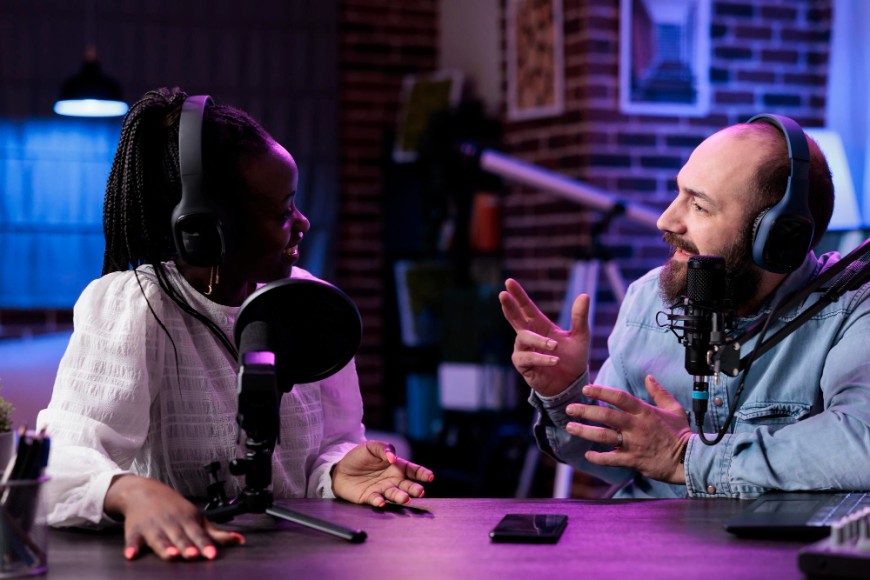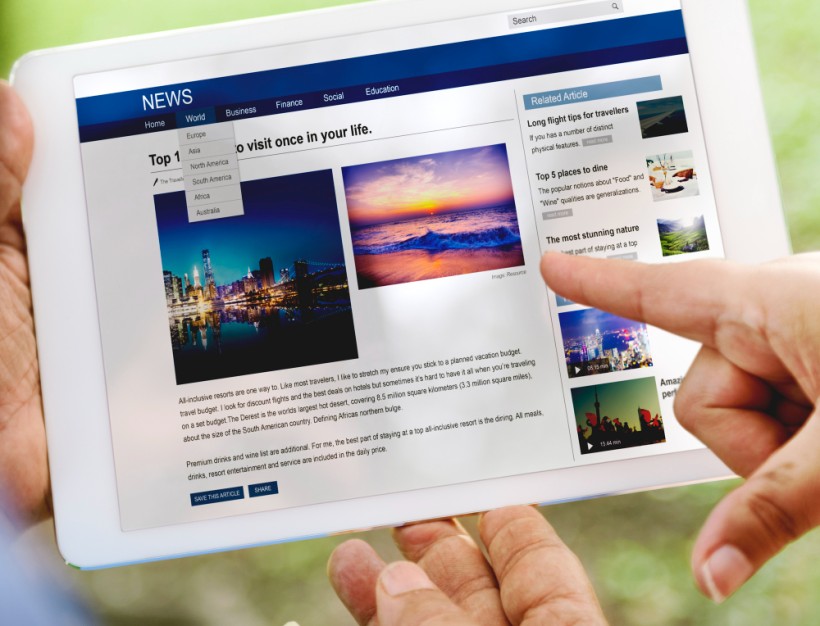TL;DR: Our MedTech LinkedIn Report shows that leadership-driven content, storytelling, audience expansion, strategic ads, and interactive formats drive the most engagement.
Alafair Biosciences had a problem—one that many MedTech companies face. They had an incredible product, VersaWrap™, changing how surgeons approach soft tissue healing.
But on LinkedIn, their message wasn’t breaking through. The content was there, but it wasn’t reaching the right people.
That changed when they took a different approach. Instead of just talking about what they built, they started focusing on why it mattered—through leadership-driven storytelling and strategic content.
Their CEO’s LinkedIn presence exploded, with a 21,058% increase in profile impressions, and their company content hit 61,570 impressions in just four months.
Alafair’s growth isn’t a one-off success story. It’s proof of what’s possible when MedTech companies take LinkedIn seriously. And that’s exactly what our MedTech LinkedIn Report breaks down.
We analyzed 20 MedTech companies, their content strategies, ad performance, and leadership engagement. The findings were clear—the companies winning on LinkedIn in 2025 are the ones that:
- Prioritize leadership visibility
- Tell better stories
- Expand their audience targeting
- Invest in ads, and
- Use more engaging formats.
The ones still relying on generic corporate updates? They’re getting left behind.
Here’s what the data says—and how you can use it to grow.
Strategy 1: Leadership Presence is the Engagement Engine
Most MedTech companies treat LinkedIn like a corporate bulletin board—posting company news, product updates, and the occasional event recap. Most of those posts barely get engagement.
The data tells us why: Leadership-driven content on LinkedIn outperforms corporate updates by 30–50%.
When founders and executives speak directly to their audience—sharing personal reflections, industry insights, and milestones—engagement skyrockets.
Why? Because people want to hear from people, not faceless brands.
Why Leadership Content Wins
When you’re in MedTech, trust is everything. Whether you’re working with healthcare providers, researchers, or policymakers, people need to believe in you before they believe in your product.
And trust isn’t built through press releases and product specs—it’s built through consistent, authentic communication.
Leadership-driven content works because:
✅ It’s personal. When a founder shares their thoughts on the future of healthcare or the challenges of scaling innovation, it feels real. It feels human. And people connect with that.
✅ It builds credibility. Executives who post regularly position themselves as thought leaders, making their companies more reputable in the process.
✅ It starts conversations. Unlike corporate updates, leadership content invites discussion, which leads to higher engagement, more shares, and expanded reach.
What High-Performing Leadership Content Looks Like
The best MedTech leaders on LinkedIn follow a simple but powerful formula: they share insights, experiences, and reflections—not just company updates.
📌 Personal reflections on industry trends
Executives who talk about where healthcare is headed and how MedTech can solve emerging challenges see significantly higher engagement than product-focused posts.
✅ Example: Hinge Health shares insights on the rise of workplace injuries and how digital care can reduce them. Their posts consistently attract HR professionals and healthcare decision-makers, averaging 85+ likes per post.
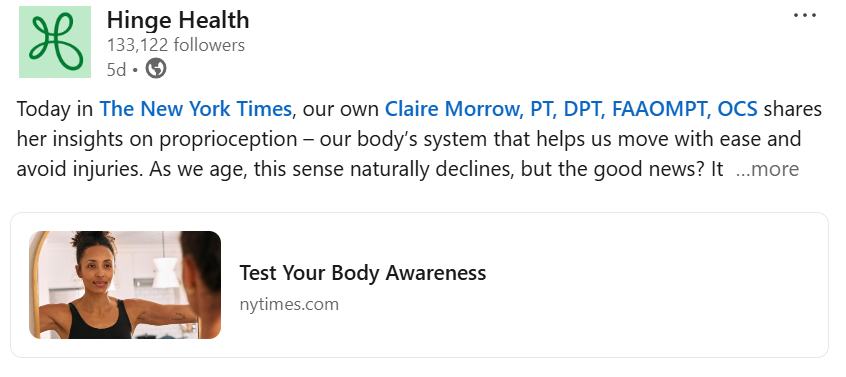
📌 Behind-the-scenes milestones
People love stories. When founders open up about their company’s journey—the wins, the struggles, the lessons—it resonates.
✅ Example: Alafair Biosciences’ CEO John Joyoprayitno shares posts celebrating team achievements and industry recognition, which get 123+ likes on average—37% higher than their product updates.
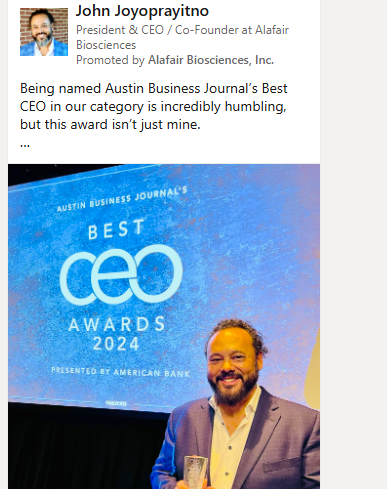
📌 Bold takes on industry challenges
The best leadership content isn’t just feel-good stories—it challenges the status quo. A well-placed “this needs to change” post can drive serious engagement.
✅ Example: Mediktor’s leadership reflections on AI in healthcare generate 20% more shares than their product-focused updates.
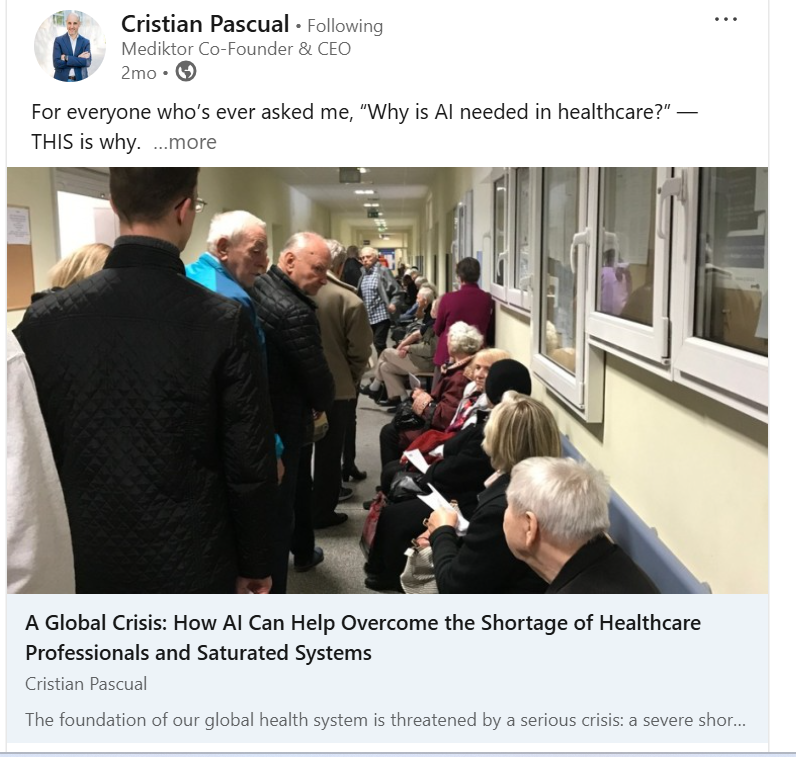
How to Make It Work for You
If you’re a MedTech founder, exec, or marketing lead, your leadership team should be posting regularly—not just when there’s a major company announcement. Here’s how to get started:
- Post at least once a week. If you’re new to this, start with short, insight-driven posts about what you’re learning or seeing in the industry.
- Make it personal. Share your experiences, your perspective, and your company’s mission in a way that feels human—not like a press release.
- Engage with your audience. Don’t just post and disappear. Respond to comments, ask questions, and start conversations. LinkedIn is a two-way street.
The Takeaway
MedTech companies that prioritize leadership-driven content will dominate LinkedIn in 2025. The data proves it. The companies already doing this are winning, and those still relying on dry corporate updates are getting left behind.
If your CEO or exec team isn’t posting yet, now’s the time to start. Your audience wants to hear from you—they just don’t know you yet.
Strategy 2: Storytelling Beats Generic Product Updates
Your LinkedIn audience isn’t looking for another product announcement. They’re looking for something that resonates, something that feels relevant to their challenges and aspirations.
And the best way to make that happen? Storytelling.
The numbers prove it: Community-driven stories and patient success stories get 2X more engagement on LinkedIn than standard product updates.
That’s because people don’t engage with features or specs—they engage with outcomes, transformation, and the human side of innovation.
If your content is all about what your product does instead of why it matters, you’re missing a huge opportunity.
Why Storytelling Works in MedTech
Healthcare is deeply personal. Whether you’re selling a groundbreaking device or an AI-driven diagnostic tool, at the end of the day, your innovation is helping real people—and that’s what your audience wants to see.
Storytelling works because:
- It creates emotional connection. A patient’s journey is more compelling than a list of technical capabilities.
- It simplifies complex innovations. Decision-makers don’t need another deep dive into specs—they need to understand how your product changes lives.
- It makes your brand memorable. Facts are easy to forget. A great story sticks.
MedTech Brands That Are Winning With Storytelling
The best MedTech companies on LinkedIn know that stories—not sales pitches—drive engagement.
📌 Abbott’s Community-Driven Content
Abbott regularly shares stories about its impact beyond products. Their posts on blood donation drives and disaster relief efforts draw 1,300+ likes per post, outperforming standard corporate updates.
✅ Why it works: They highlight real-world outcomes, making their brand feel human and relatable.
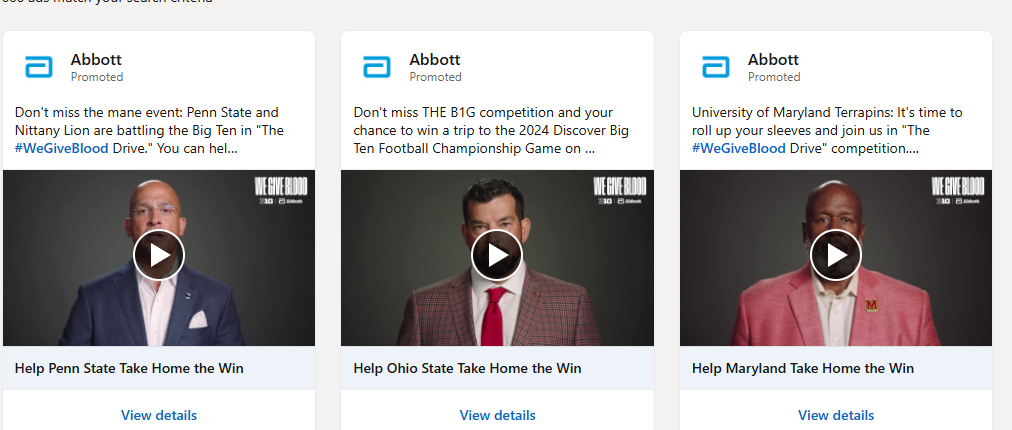
📌 Hinge Health’s Patient-Focused Storytelling
Instead of just promoting its digital musculoskeletal care solutions, Hinge Health shares how they help workers recover from injuries and improve mobility. Their content resonates with HR leaders and healthcare professionals, averaging 85+ likes per post.
✅ Why it works: It positions the company as a problem-solver, not just a product provider.
📌 Cleerly’s AI-Powered Diagnostics in Action
Cleerly turns its AI-driven cardiovascular diagnostics into real patient success stories, showing how earlier detection can save lives. Their posts consistently engage medical professionals and industry leaders.
✅ Why it works: They take something highly technical and make it easy to understand through human-centered storytelling.
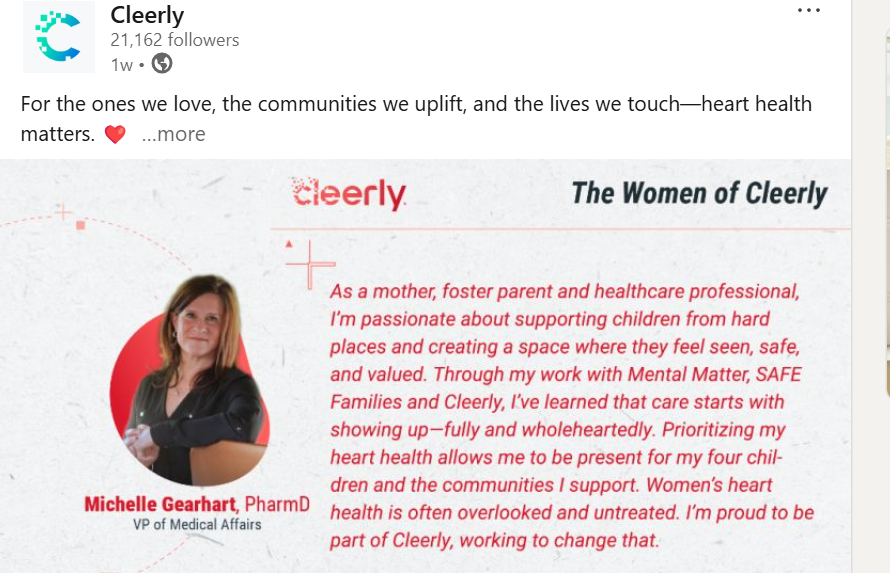
How to Apply This to Your LinkedIn Strategy
- Shift the focus from your product to your impact. Instead of just announcing a new feature, tell the story of how it helps patients, doctors, or healthcare systems.
- Use real voices. Patient testimonials, physician insights, and behind-the-scenes team stories bring credibility and engagement.
- Make it visual. Photos, videos, and carousels help bring your stories to life and make them more shareable.
The Takeaway
If you’re still treating LinkedIn like a product catalog, you’re leaving engagement on the table. Tell stories that make people feel something, and they’ll remember your brand long after they scroll past your post.
Strategy 3: Audience Targeting Must Go Beyond Just Healthcare Providers
Most MedTech companies focus their LinkedIn content on one primary audience: healthcare providers. While that makes sense—since doctors, nurses, and hospital administrators often influence purchasing decisions—it’s a limited approach.
Our data shows that MedTech companies are missing key audience segments like researchers, caregivers, and policymakers—groups that play a significant role in healthcare innovation and adoption.
Failing to engage these overlooked stakeholders means losing out on potential influence, partnerships, and opportunities.
Why Expanding Your Audience Matters
Healthcare providers aren’t the only ones shaping the future of MedTech. If you want to build industry credibility and drive more meaningful engagement, your LinkedIn strategy needs to reach beyond hospitals and clinics.
Here’s why:
- Researchers and academic leaders drive innovation and influence industry trends. Connecting with them can open doors to collaborations, clinical trials, and credibility.
- Policymakers and regulators shape the rules that MedTech companies must follow. If they don’t understand your technology, they’re less likely to support or advocate for it.
- Caregivers and patient communities play an active role in healthcare decisions. If your solution improves patient outcomes, why not engage the people directly impacted?
The MedTech Companies That Are Getting This Right
Some brands are already leading the way, using LinkedIn to engage beyond the usual suspects.
📌 Mediktor’s Research-Driven Content
Mediktor, an AI-powered healthcare assistant, shares insights targeted at researchers and healthcare IT professionals, breaking down trends in AI and digital health. Their content resonates beyond just doctors, bringing in engagement from industry analysts and clinical researchers.
✅ Why it works: They position themselves as thought leaders in healthcare AI, reaching an audience that influences MedTech adoption.
📌 Abbott’s Policy-Focused Engagement
Abbott doesn’t just talk about its products—it actively participates in conversations around healthcare access, public health initiatives, and policy changes. These posts draw engagement from policymakers, nonprofit leaders, and advocacy groups.
✅ Why it works: They educate and influence the people shaping healthcare regulations, strengthening their industry presence.
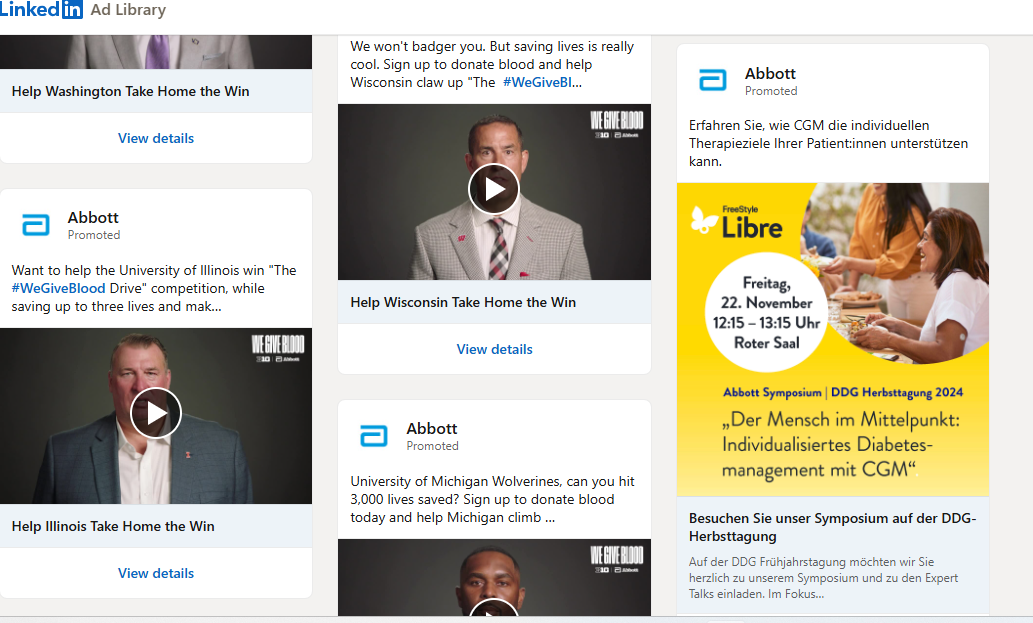
📌 Zebra Medical Vision’s Connection to Caregivers and Advocates
Zebra Medical Vision shares content that makes AI in radiology relatable to caregivers and patient advocates, not just doctors. By explaining how AI improves diagnostic speed and accuracy, they appeal to those who champion better patient care.
✅ Why it works: They speak to an audience that directly benefits from innovation, increasing demand and awareness.
How to Expand Your Audience Targeting on LinkedIn
- Segment your content strategy. Instead of writing only for doctors, create posts tailored for researchers, regulators, and patient communities.
- Address policy and regulatory changes. Educate policymakers on how your technology supports better patient care and system efficiency.
- Use real-world impact stories. If your technology improves patient outcomes, share testimonials that speak to caregivers and healthcare advocates.
The Takeaway
Most MedTech companies are talking to the same audience over and over again—but the real growth opportunities lie in engaging the decision-makers and influencers outside traditional healthcare roles.
Engage researchers, policymakers, and caregivers—not just providers—and you’ll build a far more powerful industry presence.
Strategy 4: MedTech Needs to Get Serious About LinkedIn Ads
Organic reach on LinkedIn isn’t what it used to be. The platform is getting more crowded, and competition for attention is higher than ever.
Yet, many MedTech companies still aren’t investing in LinkedIn ads—and it’s costing them opportunities.
The data shows that high-performing LinkedIn ad formats—like Thought Leader Ads (TLAs) and carousel ads—consistently exceed LinkedIn’s B2B benchmarks.
Despite this, most MedTech brands rely solely on organic content, leaving massive engagement and lead generation potential untapped.
Why Paid Ads Matter More Than Ever
LinkedIn’s algorithm favors personal connections and conversations, which means corporate content alone won’t cut it anymore.
Even great organic posts only go so far. If you want to reach decision-makers, investors, and key industry influencers, paid promotion is the best way to ensure your content is seen by the right people.
LinkedIn ads work because they:
- Amplify high-performing content—Your best posts get more visibility beyond your immediate network.
- Target the exact people you want to reach—From hospital executives to policymakers, LinkedIn’s job title targeting is unmatched.
- Drive measurable ROI—Unlike organic posts that rely on chance visibility, paid campaigns ensure your message gets in front of the right audience.
The Best LinkedIn Ad Strategies for MedTech
📌 Thought Leader Ads (TLAs)
Instead of running cold lead-gen campaigns (which rarely convert), successful MedTech brands promote their best leadership content using TLAs. This keeps prospects engaged without feeling like they’re being sold to.
✅ Example: Companies that use TLAs to boost founder and executive content see up to 50% higher engagement compared to traditional corporate posts.
📌 Carousel Ads for Storytelling
Static image ads get ignored. Carousel ads, which showcase multiple slides of value-driven content, drive higher engagement and click-through rates.
✅ Example: MedTech companies that use carousels to highlight ROI data, patient impact, or case studies consistently outperform those running basic product ads.
📌 Video Ads to Showcase Innovation
MedTech can be complex, and video is one of the best ways to simplify and explain new technologies. Short, engaging video ads work well for introducing products, showcasing research, or demonstrating real-world applications.
How to Make LinkedIn Ads Work for You
- Promote leadership content, not just corporate updates. TLAs can help amplify founder and executive posts, building credibility before pitching a product.
- Use carousel ads to highlight case studies and patient outcomes. Make the value clear and data-driven.
- Leverage video for complex innovations. Show—not just tell—why your technology matters.
The Takeaway
If your LinkedIn ad strategy is nonexistent or limited to lead-gen forms, it’s time for a rethink. The MedTech brands seeing the most success are those that blend thought leadership with paid promotion—using TLAs, carousels, and videos to drive real engagement.
Organic reach alone won’t get you where you need to go. A smart paid strategy isn’t optional—it’s essential.
Strategy 5: Interactive & Visual Content Drives Higher Engagement
Scrolling through LinkedIn, it’s clear what grabs attention: bold visuals, engaging videos, and interactive content. Yet, many MedTech companies still rely on long text-heavy posts that don’t stand out.
The data shows that visual formats—especially photos, videos, and carousels—consistently outperform text-only posts, yet they remain underutilized in MedTech. Companies that embrace interactive content see higher engagement, more shares, and better brand recall.
Why Visual & Interactive Content Wins
The algorithm favors content that keeps users engaged longer, and nothing does that better than scroll-stopping visuals, engaging videos, and interactive formats like polls or LinkedIn Live.
Here’s why it works:
- It captures attention instantly. A compelling image or video stands out in a crowded feed.
- It simplifies complex topics. MedTech can be highly technical, but visuals make innovation easier to understand.
- It increases engagement. People are more likely to comment, like, or share when the content feels interactive rather than passive.
The MedTech Companies Doing It Right
📌 Abbott’s High-Engagement Photo Posts
Abbott uses photo-driven storytelling to highlight its impact, from community initiatives to healthcare innovations.
✅ Example: A photo post celebrating a blood donation drive garnered 1,340 likes, 40% more than their text-based updates.
📌 Mediktor’s Conference Videos
Instead of posting static images from healthcare events, Mediktor uses short, engaging videos that show their AI-driven solutions in action.
✅ Example: A video post featuring their AI-powered healthcare assistant at a conference outperformed image-based posts, generating 300+ views and 26% more engagement.
📌 Zebra Medical Vision’s Infographic Strategy
Zebra Medical Vision simplifies complex AI applications with clear, easy-to-digest infographics, breaking down medical imaging insights.
✅ Example: An infographic explaining AI’s role in radiology received 89 likes, especially from healthcare IT specialists and radiologists.
How to Use Interactive & Visual Content Effectively
- Incorporate more photos and videos. Showcase your team, your technology, and the real-world impact of your work.
- Use infographics and carousels to simplify complex topics. Break down regulatory changes, research findings, or case studies visually.
- Try LinkedIn polls and live sessions. Polls encourage quick interaction, while LinkedIn Live fosters deeper engagement with Q&As or expert panels.
The Takeaway
Plain text posts alone won’t cut it anymore. The most successful MedTech brands on LinkedIn are embracing visuals, video, and interactive content to stand out.
Final Thoughts on the MedTech LinkedIn Growth Blueprint
LinkedIn isn’t just a platform for updates—it’s a trust-building machine for MedTech companies ready to use it strategically.
The data is clear: those who adopt leadership-driven content, storytelling, expanded audience targeting, smart ad strategies, and interactive formats will dominate the conversation in 2025 and beyond. See our newsletter on how to establish thought leadership in healthcare.
Work With Column to Grow Your MedTech Influence on LinkedIn
If you’re serious about using LinkedIn to position your company as a thought leader, attract decision-makers, and drive measurable business results, we can help.
At Column, we take the guesswork out of LinkedIn growth for MedTech brands—from strategy and content creation to ad amplification and audience targeting.
Let’s make LinkedIn work for you. Reach out today and let’s build your presence the right way.
Mo is the founder and CEO of Column, helping leaders shape public opinion through content and research. Connect with him on LinkedIn.




